Australian Sea Lions (Neophoca cinerea) - Kangaroo Island
 Wednesday, June 30, 2010 at 10:33PM
Wednesday, June 30, 2010 at 10:33PM 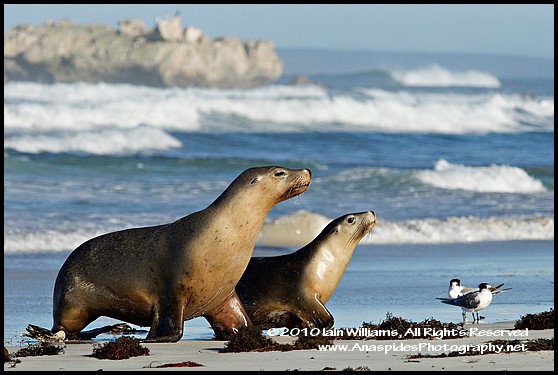 I recently spent two weeks traveling in my four wheel drive vehicle to South Australia. I spent just under a week in the northern section of the state observing Yellow-footed Rock Wallabies and a week on Kangaroo Island; Kangaroo Island is the fourth largest island in Australia located off the southern coast of South Australia. My main interest in visiting this island was to observe the abundant wildlife that calls the island home and to observe and photograph the Australian Sea Lion (Neophoca cinera) which breeds along a small section of island coastline.
I recently spent two weeks traveling in my four wheel drive vehicle to South Australia. I spent just under a week in the northern section of the state observing Yellow-footed Rock Wallabies and a week on Kangaroo Island; Kangaroo Island is the fourth largest island in Australia located off the southern coast of South Australia. My main interest in visiting this island was to observe the abundant wildlife that calls the island home and to observe and photograph the Australian Sea Lion (Neophoca cinera) which breeds along a small section of island coastline.
LEFT: Two Australian Sea Lions begin their walk up the beach after body surfing onto the beach.
The Australian Sea Lion is the fourth most endangered sea lion in the world; first on the list is the New Zealand Sea Lion (Phocarctos hookeri). Before official protection the species was regularly harvested by native people (Australian aboriginals) and European sealers. The sealers devastated many of the breeding populations and today only a few breeding sites remain in South Australia and in Western Australia.
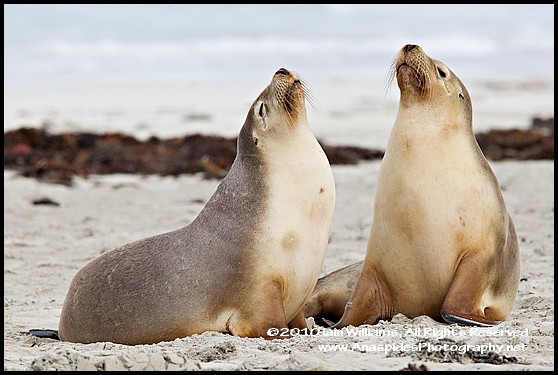 BEHAVIOUR, DIET AND THERMODYNAMICS
BEHAVIOUR, DIET AND THERMODYNAMICS
Australian Sea Lions are asocial and only come together for mating and when the mother seal tends to her pup.
LEFT: Two Female Australian Sea Lions bask in the sun. This behaviour may asi in deigestion and/or mucous drain.
Congregations of seals that appear to be lolloping together flipper over flipper are not communing with each other and are not family groups. The reason for the aggregations and apparent friendliness is basic thermodynamics – to maintain body warmth on a cold day seals lie together and appear (to us) as family groups.
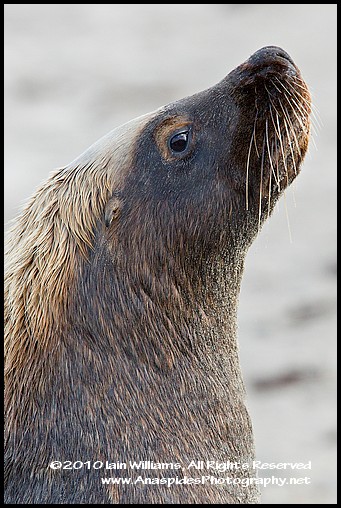 Australian Sea Lions, like their close relatives the New Zealand Sea Lion are sexually dimorphic with males portraying a vastly different appearance to females. Males can reach a length of 2.5 m (8.3 ft) and weigh in at 300 plus kg (600+ lbs) whilst the smaller females only reach a length of 1.8 m (5.2 ft) and 100 kg (220 lb) respectively. Three distinct morphs are apparent with breeding males being a darkish chocolate in colour with a very bulldog-looking head. Male adolescents are similar in colour, however, have a distinctive white mane. Females are the pretty ones with fawn and silvery coloured fur, lovely faces and very streamlined bodies. Actually, the name for the species (Sea Lion) was coined as the male’s mane reminded the biologists of the mane of a male African Lion.
Australian Sea Lions, like their close relatives the New Zealand Sea Lion are sexually dimorphic with males portraying a vastly different appearance to females. Males can reach a length of 2.5 m (8.3 ft) and weigh in at 300 plus kg (600+ lbs) whilst the smaller females only reach a length of 1.8 m (5.2 ft) and 100 kg (220 lb) respectively. Three distinct morphs are apparent with breeding males being a darkish chocolate in colour with a very bulldog-looking head. Male adolescents are similar in colour, however, have a distinctive white mane. Females are the pretty ones with fawn and silvery coloured fur, lovely faces and very streamlined bodies. Actually, the name for the species (Sea Lion) was coined as the male’s mane reminded the biologists of the mane of a male African Lion.
LEFT: A Male adolescent Australian Sea Lion poses for the camera. The white lion-like mane is very distinctive.
Like many seals the diet of the Australian Sea Lion consists of a variety of fish, shark, octopus, squid and occasionally penguins. Feeding usually occurs off the continental shelf in waters as deep as 200 m. Unlike the New Zealand Fur Seal which hauls out on rocky outcrops, Australian Sea Lions prefer sandy beaches with adjacent dune systems. The animals use the dunes as a type of incubator; when ambient temperatures are cool and the wind is blowing the animals make their way into the dunes to conserve body warmth. Conversely, when temperatures are warm, the animals migrate to the beach and water to cool off.
UNUSUAL AND UNKNOWN BEHAVIOUR
During the day the sea lion’s bask in the sun with head and necks erect maintaining an almost 90 degree angle to the sand. At first I thought this was to catch the sun, however, individuals did this even on overcast and rainy days. Speaking to a wildlife biologist it became apparent that the reason for this behaviour is unknown. Two possible reasons could be either; the positioning aids in mucous drainage to the stomach (sea lions have a lot of mucous excrement) and/or the position aids in the digestion of any meal allowing the active passage of consumed bones and detritus along the alimentary canal toward the anus.
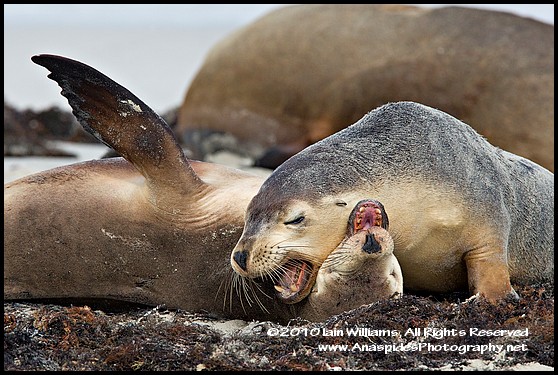 BREEDING AND PUP MORTALITY
BREEDING AND PUP MORTALITY
The breeding cycle of the Australian sea lion, which is an 18 month cycle and is not synchronized between colonies is unusual within the Pinniped family. The Sea Lion engages in serial monogamy rather than polygynous breeding; each male will attempt to maintain a small territory on the beach for a period of two to four weeks adjacent to a receptive female sea lion. During this time the male is vigilant and wards off any intruding male.
LEFT: Two Female Australian Sea Lions settle a debate over accommodation rights on the sand. Although "cute" looking, all sea lions sport large dog-like teeth that are more than capable of causing a substantial injury to anyone foolish enough to venture too close to the animal. As with all wildlife, sea lions need to be treated with the utmost respect.
 After mating with the female, he will then return to the sea, feed and relax, before returning to the beach to once again identify a receptive female, stake out his territory and wait until the female comes into estrus.
After mating with the female, he will then return to the sea, feed and relax, before returning to the beach to once again identify a receptive female, stake out his territory and wait until the female comes into estrus.
LEFT: A pregnant Australian Sea Lion pauses in her arguments with amorous males to have a closer look at the photographer.
At some breeding sites during the peak breeding times, adult males may heard receptive females in the hope of mating.
Sea Lion births occur between January and October with the female gestation period being around 12 months with the girl sea lion receptive to mating 10 days after giving birth. Unless mated after birth, a mother may nurses her pups(s) for up to 3 years.
 Pup mortality is quite high depending on environmental conditions; summer births have a mortality rate of about 7% while winter births have a mortality rate of up to 23%. At some sites sub-adult and adult male aggression towards each other can cause a mortality rate up to around 56%
Pup mortality is quite high depending on environmental conditions; summer births have a mortality rate of about 7% while winter births have a mortality rate of up to 23%. At some sites sub-adult and adult male aggression towards each other can cause a mortality rate up to around 56%
LEFT: A very small Australian Sea Lion calls for mother. The pups are especially curious of anything!
 PHOTOGRAPHING THE SEA LIONS
PHOTOGRAPHING THE SEA LIONS
Photographing the sea lions was very enjoyable and watching the antics of the youngsters even more so. At one stage I was framing a portrait of a female that was sunning herself when I heard a short sharp bark of a youngster which was emerging from the sand dunes. The pup half rolled and slid down the steep incline of the dune where gravity unceremoniously dumped him at my feet, his cute adoring face looking up at mine inquisitively. After gaining some control and dignity, he made off toward his mother who has just appeared from the ocean – no doubt the only thought on this pups mind was food!
LEFT: An adolescent female basking in the dune systems adjacent to the beach. During inclement conditions the sea lions migrate to the dunes for protection.
On another occasion I had male pups approach me wanting to play. Well, this is all I could think of as the young seal would bound right up to me, lay down on his stomach and flap his flippers about. He would then sit up and repeat the procedure seeking attention. The activity reminded me of a dog wanting to play tag or throw the bone. Although there is a temptation to actually play with the fellow, this is far from what you should do. Seal protocol is pretty straightforward in this type of situation and is always “non engagement”. It actually is better to stand up (assuming you were kneeing) which intimidates the youngster. Although appearing wrong and cruel at the time, if you do play with the baby, it is only teaching the animal that humans are fun to play with a to be around. This learned behaviour will not be welcome when the sea lion is fully grown. Imagine a 300 kg animal running towards you wanting to “play” – I think not…
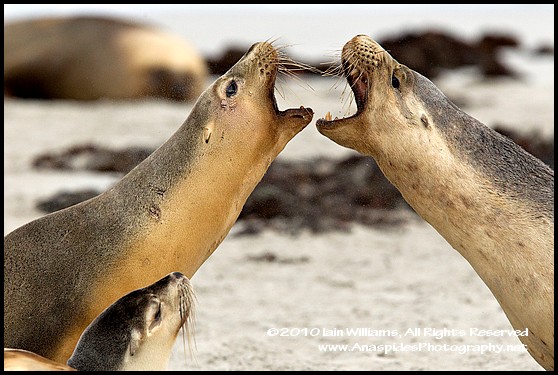 PHOTOGRAPHIC CHALLENGES
PHOTOGRAPHIC CHALLENGES
One of the biggest problems I had shooting the sea lions was not so much the number of individuals on the beach, as there were a dozen at more at any one time, but whether they had their eyes open. It seems that many sea lions need seeing eye dogs as they romp around the beach with their eyes shut. I understand that this is to protect the eye from blowing sand and the harsh sunlight.
LEFT: Being ready to photograph all the time is sometimes difficult as when the action happens it can be fast and furious. The two sea lions awoke from their slumber, argued briefly and then seperated company. The altercation was over a matter of seconds!
Compositional speaking, trying to separate a sea lion from the background or another animal was difficult. The beach on which the sea lions gather is intermittently covered in kelp and seaweed. Although the kelp looks nice, trying to position it within a defined frame can be difficult.
Environmentally the biggest hurdle was operating in a very sandy environment. The wind blew on several days and the entrained sand manages to impregnate every book and cranny in your camera equipment. It's OK shooting from a standing position as the sand is only entrained within the first foot above the ground. But, as soon as you kneel or lie prone, your equipment receives a good sandblasting.
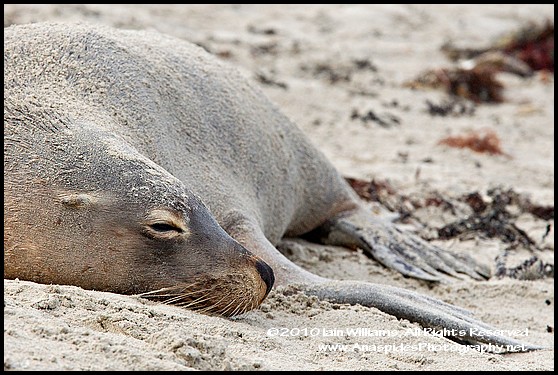 CONSERVATION STATUS
CONSERVATION STATUS
The conservation status of this species as determined by the ICUN is endangered and rthe population status is decreasing. Although numbers fluctuate between years, the average number of sea lions is 10,000 individuals. They have been totally protected since 1974.
LEFT: Sleeping seems to be a good part of any sea lion's daily activities. However, sleep and rest is important as these animals regularly spend a few days at sea traveling vast distances in search of prey. It's important to try and not disturb a sleeping animal.
I enjoyed my time with the sea lions and I hope you have enjoyed reading about them...
To see more Australian Sea Lion images, type the name into the search box or search the stock gallery. See also Photo of the Month.



Reader Comments (4)
Hi Ian - Good shots and fascinating natural history. Thanks for posting this. Your blog is very interesting and I like the way its' about the animals rather than the person. I work for a book publishing house and am interested in using some of your images for natural history books we are publishing soon. I have e-mailed you, but thought it best to also include a quick message for you here. Regards Tom
Hello Tom,
Thank you for you nice words; glad you enjoyed the post and images. Best to you, Iain
Hi Ian, This is such an awesome post -- I've had it marked unread in my reader for what has apparently been months, with the intention of coming back to leave a comment. Terrific information, and the images are beautiful. Sea lions in general are such charismatic animals, and the sleek fur and coloration of these Australians is really captivating. What a great experience it must have been to spend time with them. I really love the portrait of the adolescent male -- there's just something about it that I can't get enough of (perhaps it reminds me a bit of the dogs I had during my childhood). Anyway, really brilliant post!
Hi Pat: Thanks for your note! I find that many people just talk about themselves on their blog. Whilst this is not a bad thing, it does get tiresome. I guess a middle ground needs to be reached. Best, Iain